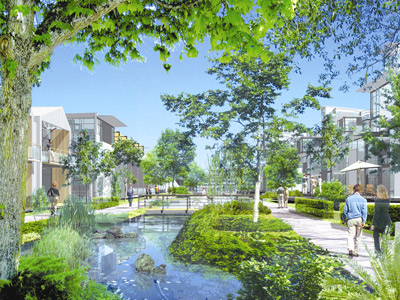What Will Sugar House look like in the Future? The Future Will Tell.
Places that attract residents and tourists are unique. It takes a commitment to ensure that places like Sugar House retain their flavor and make themselves successful and vibrant. We have to work to sustain the quality of life that we enjoy.
—Søren Simonsen, 2006
In August 2013, the author conducted an informal survey to learn how people thought Sugar House will look at the end of the decade. This is a summary of what she heard.
DATELINE: SUGAR HOUSE, 2020 —
In the seven years since the streetcar slid into Sugar House, the Business District’s population has grown by 2,000 individuals. A half-billion dollars of private money, added to the public investment in transit and open space, has resulted in hundreds of new jobs in the downtown area. Young people seeking to avoid the expense of owning an automobile have chosen to live near their work. Pedestrians fill the sidewalks, trails, and Greenway Street; parks and public open spaces are crowded with people and their dogs.
— As older residents leave their classic bungalows in the Westminster and Fairmont neighborhoods, young buyers clamor to buy houses at record prices. Townhomes and multi-family units are selling rapidly as Freddie Mac and other conventional mortgage lenders relax their requirements for lending.
— Drawn by its carefully preserved historic character, tourists easily navigate the sidewalks and mid-block pathways of downtown Sugar House. At night, vintage neon and colorful overhead signs help visitors to find their way to the upscale restaurants, playhouse and movie theaters surrounding a new 150-room hotel and community center.
— Sugar House continues to enjoy its reputation as a great regional shopping center. Clients and customers drive from other quadrants of the valley to patronize their favorite local businesses, and enjoy the “lock and walk” convenience of leaving their cars in one of several secure, paid-parking structures in the Business District.
— The value of properties next to embedded rail transit has risen along with profits for businesses located within a half-mile of the streetcar line. High-intensity commercial development has spread along 2100 South, with office buildings replacing outdated stripmall construction between 900 East and 700 East. Start-up businesses incubate in lower-priced properties on 1100 East, and flourish in the remaining historic buildings around the business core.
— Finally, Sugar House has re-emerged as a center for local arts and culture. The Business District is distinguished by its galleries and public art. Outdoor concerts, art strolls, street performers and festivals add to the dynamic street life for which the community is celebrated.
Merchants with a retail trade in art supplies and frames were prepared for the rise in rents and competition from chain stores that came with the new development in Sugar House. Small retailers who wanted to stay in the District found partners to share their rent.
The commercial boom was hard, however, on the studio artists who worked downtown. Their presence always depended upon landlords who were willing to offer spaces at affordable rents for studios and eclectic shops. Some artists supplemented the income from selling their work by offering classes, workshops, or by renting gallery space to other artists in order to meet expenses. Other artists and vendors formed co-operatives like Local Colors of Utah, and one group organized to create an indoor art mall. Those who couldn’t pay higher rents moved outside of the town center, and bought space at weekly craft and farmers’ markets to showcase their products.
For decades, people have said that Sugar House is too expensive and too congested… but they still love it. For those who want to live here, new housing opportunities have made it possible. Revived by recent residential and commercial development, business has improved for retailers. And for everyone who was able to adapt to the changes, in 2020 life in the Sugarhood is still very good.
Change is constant. Sugar House is no exception. It is necessary in a growing community. §






